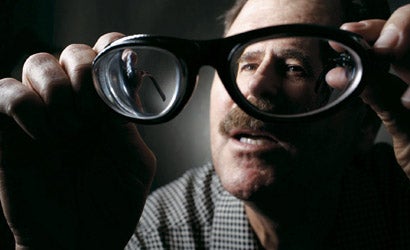Eye Contact: How an accident saved one man’s sight.
An article for Pop Photo turns up a serum that even top doctors didn't know about.

Contributing Editor Neal Matthews is one tough hombre.
In pursuit of articles for various magazines, he’s joined smugglers running from Cuba to Florida, trained offshore with Navy frogmen, and even crawled through Southern California storm sewers to get into the world of forbidden photography.
He’s brave. Fighting Hodgkin’s Lymphoma for the past five years, he continues to produce one outstanding article after another.
And he’s resourceful. When it comes to performing research, interviewing sources, and getting the facts, Neal is unmatched.
That’s why I assigned him “The Photographer’s Guide to the Eye,” which appears in this issue. I figured nobody could better investigate how advances in vision research can be used to understand and improve photographic technique.
I had no idea Neal’s own medical battles had left him with eyes that were not just dry, but in a very real sense, dying, slowly and painfully day by day. And there seemed to be little doctors could do for him and the thousands in similar straits.
As it turns out, no article Neal has produced in his 30-year writing career will so profoundly affect lives — including his own.
I’ll let Neal pick up the story…
| Read the story on perception Neal was working on when he discovered this remedy: The Photographer’s Guide to the Eye. The Hungry Eye Eating your way to better pictures. |
My eyes were dry as marbles when I squeezed between the tall metal shelves upstairs in the UC San Diego Biomedical Library.
I haven’t been able to produce tears for three years, and although I was wearing prescription goggles to hold in moisture, the dryness and pain never stop.
Still, I was determined to find the journal I’d come for. Just as I was pulling it from the shelf, I noticed another, Current Eye Research.
Curious, I flipped it open. The first headline I saw blew me away: “Albumin Rescues Ocular Epithelial Cells from Cell Death in Dry Eye.” First sentence: “Because autologous serum is useful for the treatment of severe dry eye…”
Dull medico-babble? Hardly. These were the most beautiful words I’d seen since my long-ago wedding invitation.
Autologous serum is what you get when somebody spins your blood in a centrifuge and separates the plasma (serum) from the red blood cells.
Mixing this albumin-rich, home-grown elixir with saline and using it for customized eye drops has been going on all over the world for 10 years, with ongoing research by Brazilian, Indian, and Japanese scientists. Dry eye in those countries is a huge and growing problem, because so many diseases that go untreated can attack, and shut down, the eye’s tear-making apparatus.
But this solution (because Big Pharma’s not involved?) is not as well known here in the United States.
I’ve had two bone marrow/stem cell transplants. The unremitting pain in my eyes, mouth, and bones effected by the last one hasn’t let up for 1,095 days. Though none of my doctors had heard of serum eye drops, when I told them about the studies, they wrote me a prescription.
The only pharmacy I could find in the country that mixes this potion is Leiter’s in San Jose, CA, a well-known compounder of unusual remedies. The medical center at UCSD tested me for AIDS and hepatitis, drew a bag of blood, cultured it for a week to make sure it was free of infectious diseases, then spun it down and separated the serum. Leiter’s filtered it and added saline for a 50/50 solution.
Eighteen bottles of the precious concoction soon arrived by courier.
I dropped my own blood serum into my eyes, and they felt great. A miracle? A placebo? Does it matter?
It’s still too soon to say if these drops will heal my eyes, though I’m optimistic. I hope this small personal advance — as well as this column — will help spread the word about these drops and bring relief and hope to others.
None of it would have happened without the assignment for Pop Photo. That’s the miracle.
The Photographer’s Guide to the Eye